A Journey Through the Scott Creek Watershed
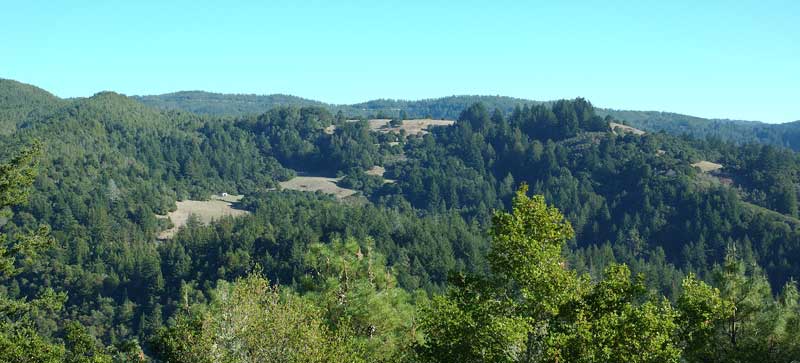
 Seymore Hill
Seymore Hill
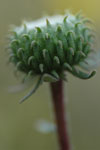 After being physically constrained by the gauntlet of manzanitas and knobcone pines
(Pinus attenuata) that characterize upper Schoolhouse Ridge, experiencing the panoramic view of the watershed,
its vastness and topographical complexity, gives one insight—an epiphany if you like—into the evolutionary dynamics, both
geological and biological, which have given rise to the biodiversity that is the hallmark of our watershed.
After being physically constrained by the gauntlet of manzanitas and knobcone pines
(Pinus attenuata) that characterize upper Schoolhouse Ridge, experiencing the panoramic view of the watershed,
its vastness and topographical complexity, gives one insight—an epiphany if you like—into the evolutionary dynamics, both
geological and biological, which have given rise to the biodiversity that is the hallmark of our watershed.
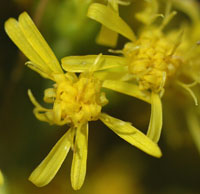 The summit of Seymore Hill is ringed with grasslands sheltering scattered clusters
of California fuchsia (Epilobium canum subsp. canum), displaying cinerous foliage
framing tubular scarlet flowers that glow like hidden caches of rubies when backlit by the setting sun.
The summit of Seymore Hill is ringed with grasslands sheltering scattered clusters
of California fuchsia (Epilobium canum subsp. canum), displaying cinerous foliage
framing tubular scarlet flowers that glow like hidden caches of rubies when backlit by the setting sun.
A quintet of Aster kin punctuate the weathered mudstone and offer students of systematics and ecology a unique opportunity to study reproductive isolating
strategies between sympatric related taxa—hirsute gumplant (Grindelia hirsutula);
a glandular ecotype of the bristly golden aster Heterotheca sessiliflora subsp. bolanderi); California goldenrod
(Solidago velutina subsp. californica); coyote brush (Baccharis pilularis subsp. pilularis); and California-aster (Corethrogyne filaginifolia).
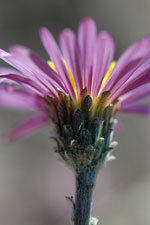
Two of the three documented Clarkias for the immediate area manage to stake out territories along the wind-buffeted margin of the exposed
ridgetop—farewell-to-spring (Clarkia rubicunda)
and four-spotted godetia (Clarkia purpurea subsp. quadrivulnera), the seeming fragility of their lilac/lavender flowers offset by the production of numerous fertile capsules and remarkably stable population sizes.
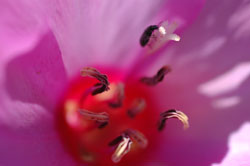
Responding to prevailing winds out of the northwest, Spanish trefoil (Acmispon americanus var. americanus) radically altered its erect-ascending mode of growth by lowering its profile and becoming a visually attractive mat. Visually obscured by the burnished end-of-season tangle of grass stalks, harvest brodiaea (Brodiaea elegans subsp. elegans) leaves a diffuse trail of amethyst dust when viewed from afar, while Kellogg's yampah (Perideridia kelloggii), the more common of the two species of this genus to be found within the watershed, plays sentinel to the proceedings.
Located between the uppermost limits of Schoolhouse Ridge and the emergence of the "Chalks," Seymore Hill presents two radically differing profiles:
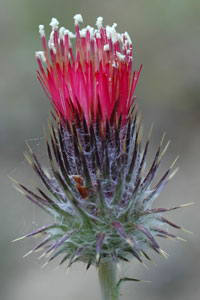 facing eastward towards the upper Mill Creek watershed and dropping off precipitously is an interrupted series of near-vertical grasslands.
Finding sanctuary in this most precarious of habitats, the families Boraginaceae and Ranunculaceae contribute two members each—nievitas
(Cryptantha flaccida), its stems and calyces clothed with glistening encrusted trichomes, and rusty popcornflower (Plagiobothrys nothofulvus),
staining hands and herbarium sheets purple with anthocyanin colored sap. These occupy separate niches from two sympatric taxa of Delphinium—western
larkspur (Delphinium hesperium subsp. hesperium), extremely rare within the watershed, and woodland larkspur (Delphinium patens subsp.
patens), distinct from the typical local form with plants pubescent not glabrous. Contrasting exserted reddish corollas with a densely cobwebby indument,
Venus thistle (Cirsium occidentale var. venustum), makes scattered appearances, its sparsity offset by the Faberge-like intricacy of its discoid
flower-heads.
facing eastward towards the upper Mill Creek watershed and dropping off precipitously is an interrupted series of near-vertical grasslands.
Finding sanctuary in this most precarious of habitats, the families Boraginaceae and Ranunculaceae contribute two members each—nievitas
(Cryptantha flaccida), its stems and calyces clothed with glistening encrusted trichomes, and rusty popcornflower (Plagiobothrys nothofulvus),
staining hands and herbarium sheets purple with anthocyanin colored sap. These occupy separate niches from two sympatric taxa of Delphinium—western
larkspur (Delphinium hesperium subsp. hesperium), extremely rare within the watershed, and woodland larkspur (Delphinium patens subsp.
patens), distinct from the typical local form with plants pubescent not glabrous. Contrasting exserted reddish corollas with a densely cobwebby indument,
Venus thistle (Cirsium occidentale var. venustum), makes scattered appearances, its sparsity offset by the Faberge-like intricacy of its discoid
flower-heads.
Topographically complex and botanically diverse, the Scott Creek aspect of Seymore Hill is bounded by a series of interrupted, asymmetrical grasslands, flanked and bisected lengthwise by Bettencourt and Calf gulches, and margined by a mosaic of mixed evergreen/coniferous woodlands and disjunct manzanita populations. Within an area circa 300 m x 50 m, aligned along a north/south axis, and abutting the source of Calf Gulch, four valid and two recognized but unpublished species of Sanicula (family Apiaceae) have been documented. Growing vertically on a grassy slope and sympatrically with, but reproductively isolated from, the common gambleweed (Sanicula crassicaulis) is Sanicula "pseudo-laciniata"—differing consistently from Sanicula crassicaulis sensu strictu in foliar morphology; the possession of bright, clear-yellow flowers with large, like-colored anthers; and a distinct chemical signature.
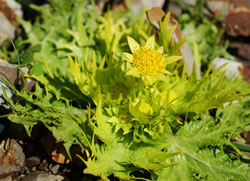 Occupying a transitional zone, between the vertical grassland and oak woodland, footsteps-of-spring (Sanicula arctopoides) and purple sanicle
(Sanicula bipinnatifida), are often obscured from direct viewing by the competing grasses. Located deep within the oak understory, where light
is subdued and less moisture is given up due to the actions of sun and wind, the listed Hoffmann's sanicle (Sanicula hoffmannii) shares
Occupying a transitional zone, between the vertical grassland and oak woodland, footsteps-of-spring (Sanicula arctopoides) and purple sanicle
(Sanicula bipinnatifida), are often obscured from direct viewing by the competing grasses. Located deep within the oak understory, where light
is subdued and less moisture is given up due to the actions of sun and wind, the listed Hoffmann's sanicle (Sanicula hoffmannii) shares
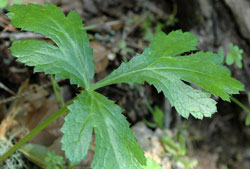 its domain with the repeatedly misdiagnosed, still undescribed Sanicula "gianonei" pro. sp. nov.—the criteria used
to define this widespread taxon center on ecology/habitat preference, biochemical signature, foliar/bractmorphology and marginal trichomes, flower color,
an unblemished epigynous disc, and schizocarp configuration/alignment of uncinate bristles.
its domain with the repeatedly misdiagnosed, still undescribed Sanicula "gianonei" pro. sp. nov.—the criteria used
to define this widespread taxon center on ecology/habitat preference, biochemical signature, foliar/bractmorphology and marginal trichomes, flower color,
an unblemished epigynous disc, and schizocarp configuration/alignment of uncinate bristles.
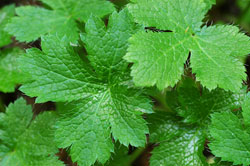 Staying within and adjacent to the "Sanicula Rectangle," several "pairs" of related species have been observed,
these juxtapositions rarely or never encountered elsewhere within the watershed. Sharing a narrow, quasi-vertical exposure of moss-bedecked mudstone,
woodland star (Lithophragma affine) and hill star (Lithophragma heterophyllum) grow overlooking the steep and tortuous drop
characterizing the upper reach of Calf Gulch.
Staying within and adjacent to the "Sanicula Rectangle," several "pairs" of related species have been observed,
these juxtapositions rarely or never encountered elsewhere within the watershed. Sharing a narrow, quasi-vertical exposure of moss-bedecked mudstone,
woodland star (Lithophragma affine) and hill star (Lithophragma heterophyllum) grow overlooking the steep and tortuous drop
characterizing the upper reach of Calf Gulch.
Occupying an exposed and consequently far drier vertical grassland habitat, godetia (Clarkia purpurea subsp. purpurea)
and four-spotted godetia (Clarkia purpurea subsp. quadrivulnera) represent two extremes in population
demographics—subsp. purpurea being rare or extirpated throughout its known range and subsp.
quadrivulnera's status being common and widespread.
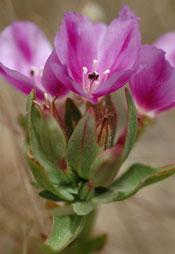
A variation on the Clarkia purpurea paradigm is the pairing of slender cottonweed (Micropus californicus var. californicus) and green cottonweed (Micropus californicus var. subvestitus), the latter of which has not been documented anywhere else in the County. The more frequently encountered slender cottonweed was discovered, circa 400 m lower down the Seymore Ridge, growing in another narrowly delimited grassland edge proximal to two rare, listed taxa—San Francisco popcorn-flower (Plagiobothrys diffusus) and Santa Cruz clover (Trifolium buckwestiorum).
Returning to the aforementioned "vertical grasslands," this one nearer to the summit of Seymore Hill, two sister species of Agoseris occur, their differences mainfested in growth habits and conspicuously dissimilar mature flower heads/achene morphologies—large-flowered agoseris (Agoseris grandiflora var. grandiflora), a robust perennial with stout stems supporting the outsized fruiting heads held above the surrounding grasses, and annual agoseris (Agoseris heterophylla), a diminutive and delicate annual, usually overtopped by seasonal grasses and possessing polymorphic achenes, variable both as to color and structure.
All photographs © Dylan Neubauer